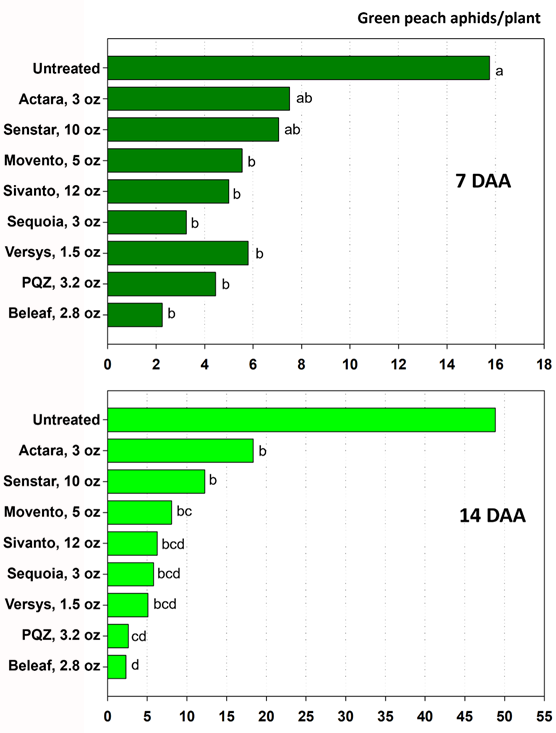Aphids continue to be abundant in area lettuce and it is turning out to be the heaviest green peach aphid (GPA) pressure I’ve seen in several years. In untreated lettuce plots at YAC, GPA populations have steadily been increasing since early February. For example, aphid numbers increased from an average of 8 GPA/plant to greater than 48 GPA /plant in untreated lettuce over the past 2 weeks. In my experience, this is largely due to weather conditions. Temperatures summarized from the UA AZMET station at YAC shows that average temperatures from Jan 1 to Feb 20 have been about 55 °F (4 degrees cooler than last winter). This winter relative humidity has been almost 10% higher and we’ve had 3X more rainfall than last year. These are ideal conditions for GPA population growth in the desert – cold and wet. These conditions can also make control more difficult. I’ve had numerous discussions with PCAs concerning the slow activity of the insecticides used for desert aphid control. I’ve observed for years that translaminar and systemic insecticides work slower under cold desert growing conditions. Cold weather will limit movement in the plant, particularly xylem/phloem mobile products like Movento, because plant growth and transpiration are limited under cold, cloudy weather. But as weather gets warmer, the activity of systemic insecticides improves dramatically. With translaminar insecticides (aphids have to ingest the toxin) the challenge is getting spray coverage on the older frame leaves where GPA feed and colonize. This can be a real challenge on larger plants.
The good news is that most products I’ve evaluated so far this season are performing as expected, but may be taking longer to achieve the level of control that you would like to see. Below are the results of an on-going aphid efficacy trial I’m conducting at YAC on iceberg lettuce planted 9 Dec. The first spray was applied on 3 Feb by ground at 23.6 gpa @ 50psi. An adjuvant, Dyne-Amic was applied with each spray treatment. Lettuce plants were at the 7-8 leaf stage at the time of application. To evaluate efficacy, all live aphids were counted on 5 whole plants per replicate at 7 and 14 days after application (DAA). At 7 DAA (Feb 10), results were inconsistent, but most treatments provided significant reductions in GPA compared to the untreated control (65-85% control). However, at 14 DAA (Feb 17), Beleaf and PQZ provided the most consistent reductions of GPA (95% control), whereas Versys, Sequoia and Sivanto provided similar reductions in GPA abundance at ~90% control. Not surprisingly, Movento and Senstar were less consistent under the colder weather. So be patient with aphid control under cold weather conditions. Remember the key with the translaminar products for GPA control is getting the material to the older leaves where they are colonizing. Once the weather warms up a bit, the systemic products will be much more effective. For more information on insecticides alternatives see Aphid Management in Desert Produce Crops - 2023






